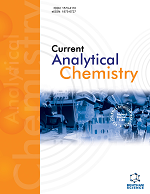- Home
- A-Z Publications
- Current Analytical Chemistry
- Previous Issues
- Volume 4, Issue 1, 2008
Current Analytical Chemistry - Volume 4, Issue 1, 2008
Volume 4, Issue 1, 2008
-
-
Membrane Domain Distributions: Analysis of Fluorescence Sterol Ex-change Kinetics
More LessIt is well known that cholesterol is localized in a non-random distribution within and across biological membranes. The importance of the cholesterol-enriched domains, also termed rafts, is evident from the fact that non-receptormediated cholesterol uptake and reverse cholesterol transport also occur through select plasma membrane domains. However, despite much effort to resolve the mechanisms that explain t Read More
-
-
-
T2ρ and T1ρ Adiabatic Relaxations and Contrasts
More LessAuthors: Shalom Michaeli, Dennis J. Sorce and Michael GarwoodTransverse relaxation in the rotating frame (T2ρ) is the dominant relaxation mechanism during a train of adiabatic full passage (AFP) radiofrequency (RF) pulses with no interpulse time intervals placed after the 90° excitation pulse. The magnetization components remain transverse to the time-dependent effective field and undergo relaxation with the time constant T2ρ. Longitudinal relaxation in the rotati Read More
-
-
-
Structural Analyses of Carbohydrate Moieties of Glycoproteins by Microwave-Assisted Partial Acid Hydrolysis and Mass Spectrometry
More LessCharacterization of carbohydrate moieties of glycoproteins using microwave-assisted partial acid hydrolysis (MAPAH) and mass spectrometry (MS) are described in this review. Acids including hydrochloric acid (HCl), trifluoroacetic acid (TFA), and phosphoric acid (H3PO4) can be used to induce partial hydrolysis of the carbohydrate moieties of glycoproteins in as short as 30 s of microwave exposure. High resolving power of MS a Read More
-
-
-
Magnetic Resonance Spectroscopy with Longitudinal Multispin Orders
More LessLongitudinal multispin orders can be created in spin systems that exhibit scalar, dipolar or quadrupolar couplings. They provide an effective way for measurement of scalar couplings and also to probe molecular interactions and dynamics. They cannot be separated by phase cycling or gradient selection methods which are the only known modes of separating different coherences. In this review we describe the frequency cycling Read More
-
-
-
Experimental Design Techniques for Optimization of Analytical Methods. Part I: Separation and Sample Preparation Techniques
More LessAuthors: Federica Bianchi and Maria CareriA review is presented on recent applications of experimental design and optimization techniques for the analysis of compounds of food, biomedical, toxicological and environmental concern. The main features and the significant advantages of chemometric approaches are discussed. Examples related to the determination of substances like xenobiotics or naturally occurring compounds using different analytical techniques, i.e. g Read More
-
Volumes & issues
-
Volume 21 (2025)
-
Volume 20 (2024)
-
Volume 19 (2023)
-
Volume 18 (2022)
-
Volume 17 (2021)
-
Volume 16 (2020)
-
Volume 15 (2019)
-
Volume 14 (2018)
-
Volume 13 (2017)
-
Volume 12 (2016)
-
Volume 11 (2015)
-
Volume 10 (2014)
-
Volume 9 (2013)
-
Volume 8 (2012)
-
Volume 7 (2011)
-
Volume 6 (2010)
-
Volume 5 (2009)
-
Volume 4 (2008)
-
Volume 3 (2007)
-
Volume 2 (2006)
-
Volume 1 (2005)
Most Read This Month
Article
content/journals/cac
Journal
10
5
false
en


